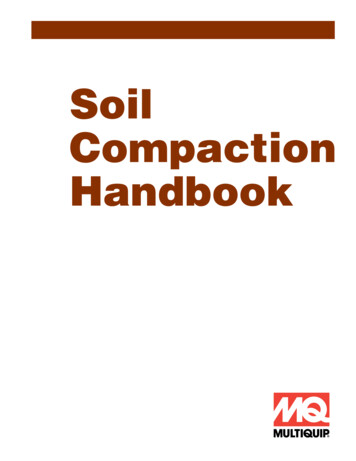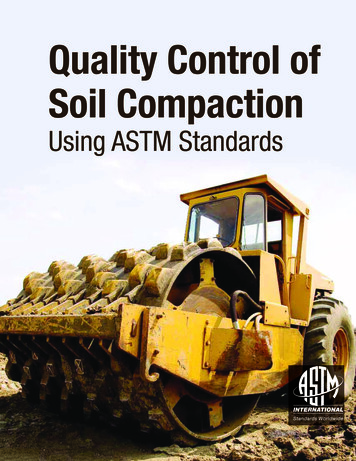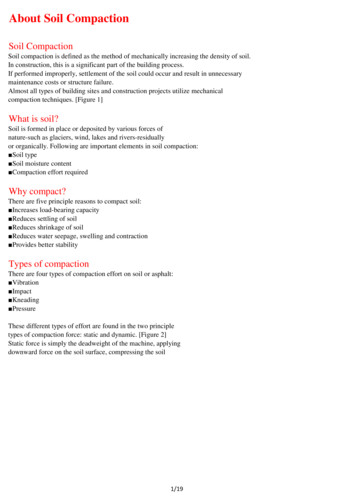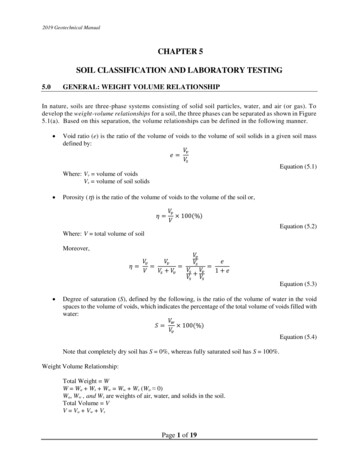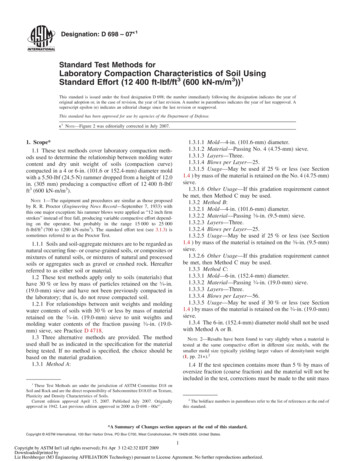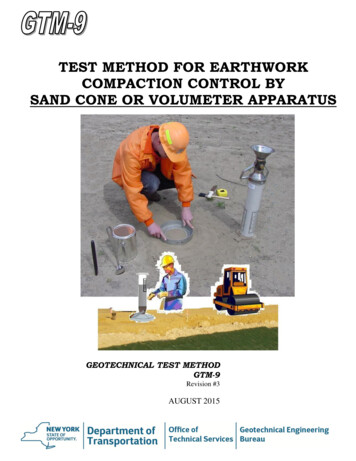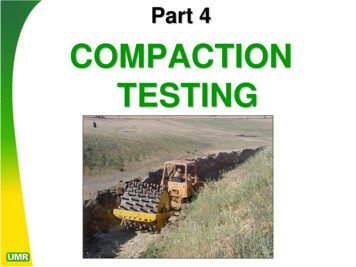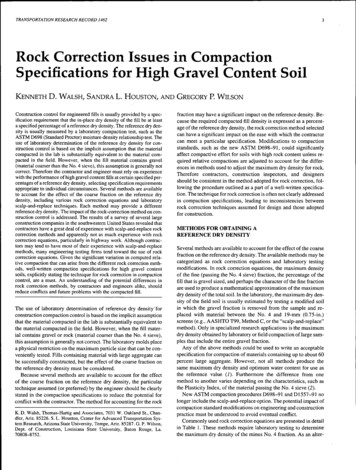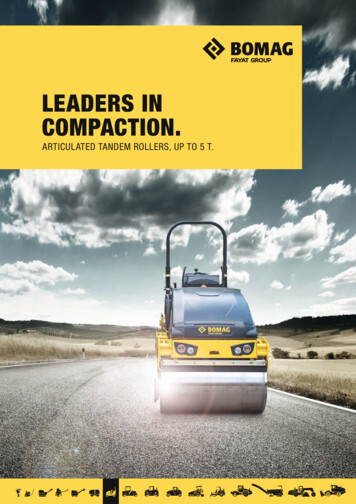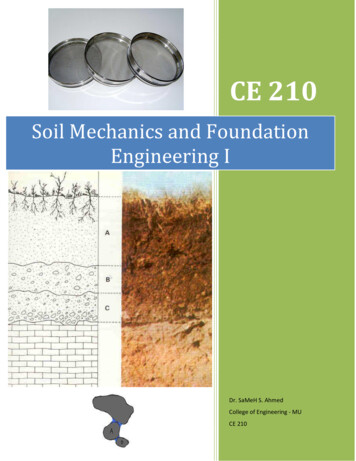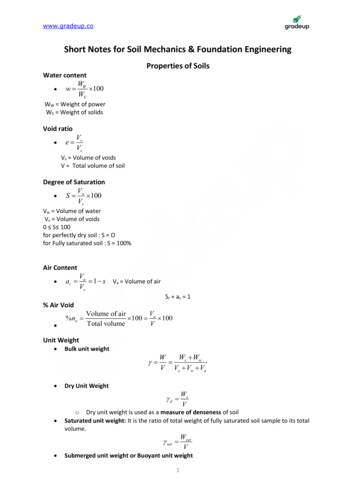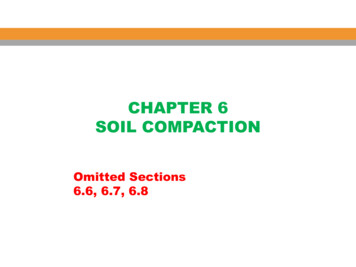
Transcription
CHAPTER 6SOIL COMPACTIONOmitted Sections6.6, 6.7, 6.8
SOIL COMPACTION In Geotechnical engineering practice, the soils at a given siteare often less than desirable for the intended purpose. Theymay be: Weak (strength) Highly compressible Have a high permeabilitySolution Relocate the project Articulate design for structure members Stabilize or improve the properties of the soilThe third alternative may be in most cases the most economicalalternative. There are different techniques for improvement of soils(This subject is covered in details in CE 486 “Improvement ofGeotechnical Materials”).We will consider in this course only compaction.
SOIL COMPACTION Compaction is also very important when soil is used as anengineering material, that is the structure itself is made of soil.Ex. Earth dams Highways Airfields etc.DefinitionCompaction is the densification of soils by removal of airthrough the application of mechanical energy.The degree of compaction is measured in terms of its dry unitweight.
SOIL COMPACTION Increases unit weight Increases shear strength Increases bearing capacity Increases stability of slopes of embankments Decreases settlement of structures
SOIL COMPACTIONYou remember olid
SOIL COMPACTIONGeneral PrincipleThe degree of compaction of soil is measured by its dry unit weight.When water is added during compaction it acts as a softening agenton the soil particles.gd(max)When the moisture content isgradually increased, the weightSoil Solidof the soil solids in a unitvolume gradually increases.waterSoil Solid Optimum moisture content (OMC) is the water content atgwhich the maximum dry unit weight d (max) is attained.
SOIL COMPACTIONSoil SolidwaterSoil Solid
SOIL COMPACTIONTypes of Compaction Methods in the Laboratory Impact or dynamic (The most common type) Kneading Static The laboratory test generally used to obtain the maximum dryunit weight of compaction and the optimum moisture content iscalled the Proctor compaction test. It is named after R. R. Proctor (1933) (engineer in LA). Heestablished that compaction is a function of:1.Moisture Content2.Compactive Effort3.Soil Type There are two methods or tests: Standard Proctor test (ASTM D-698 & AASHTO T-99) Modified Proctor test (ASTM D-1557 & AASHTO T-180)
Standard Proctor Test Mold 1/30 ft3 in volume 3 layers 25 blows 5.5 lb hammer 12 inch dropMoldHammerThe procedure for the standard Proctor test is elaborated in ASTMTest Designation D-698 (ASTM, 2007) and AASHTO TestDesignation T-99 (AASHTO, 1982).
Standard Proctor Test
Standard Proctor TestProcess of Compaction Several samples are mixed at different water contents Compact according to the compaction test (standard or modified).g moist WVmoldW Weight of compacted soil in the moldVmold Volume of the mold (1/30 ft3) For each test find the moisturecontent of the compacted soil. The dry unit weight is given bygd Plotgdg moist1 wvs. w From the plot, find OMC andg d (max)
Standard Proctor Test In order to avoid a large number of compaction tests, it isdesirable to begin the first test at a moisture content that is about4 to 5% below the approximate optimum moisture content.
Standard Proctor TestREMARKS1. Each data point on the curve represent a single compaction test.2. Four or five tests are required3. The curve is unique for:- A given soil type- Method of compaction- (constant) compactive effort4. gd(max) is only a maximum for a specific compactive effort and method ofcompaction. This does not necessarily reflect the maximum dry unit weightthat can be obtained in the field.5. Typical OMC are between 10% and 20%. Outside maximum range 5% to40%.
Standard Proctor Test6. Increasing the compactive effort tends to increase the maximum drydensity, as expected, but also decrease the OMC. (This is why the curvenever be to the right of zero curve).7. In practice less amount of water is used but higher compactive effort orvise versa.8. For clay soils gd(max) tends to decrease as plasticity increases.9. The approximation to field is not exact because the lab. test is a dynamicimpact type, whereas field compaction is essentially a kneading-typecompaction.10. In the field, compactive effort is the number of passes or “coverage” of theroller of a certain type and weight on a given volume of soil.
Standard Proctor TestTheoreticalg d(max)The maximumg d (max)is obtained when no air in the voids (i.e. s 100%)gd butforGsgw1 ewGs seS 100% e wGsGsgg z av gw 1 w1 wGs wGsWhere gzav zero air void unit weight. The relationship between gzav and w can be obtained as shown in the figure across. Compaction curve is always to the left of the zero-air-void curve.No matter how much water is added, the soil neverbecomes completely saturated by compaction.
Standard Proctor TestTo obtain the variation of gzav with moisture content, usethe following procedure:Under no circumstances should anypart of the compaction curve lie tothe right of the zero-air-void curve.
FACTORS AFFECTING COMPACTIONBesides moisture content, other important factors that affectcompaction are: 1) Soil type; 2) Compaction effort.1. Effect of Soil Type Grain Size Distribution Shape of the soil grains Gs Amount of clay minerals Type of clay mineralsFine grain soil needs more waterto reach optimum.
FACTORS AFFECTING COMPACTIONEffect of Soil type and gradationFine grain soilneeds more waterto reach optimum.
FACTORS AFFECTING COMPACTIONGsgwg z av gw 11 wGs wGsEffect of Soil type and gradationTypical Valuesg d (max)(kN/m )3OMC (%)Well graded sandSW227Sandy claySC1912Poorly graded sandSP1815Low plasticity clayCL1815Non plastic siltML1717High plasticity clayCH1525 Gs is constant, therefore increasing maximum dry unit weight is associatedwith decreasing optimum moisture contents. Do not use typical values for design as soil is highly variable.
FACTORS AFFECTING COMPACTIONCompaction Curves Encountered in Soils Thebell-shaped compactioncurve is typical for most clayeysoils.Typical Somecurves have morethan one peak others have nopeak.
FACTORS AFFECTING COMPACTION2. Effect of Compaction EffortStandard ProctorFor the standard Proctor test The standard Proctor mold andhammer were used to obtain thesecompaction curves.For all cases the number of layerswas equal to 3.Compaction effortgd maxwopt.
EXAMPLE 6.1TEXT IN SI UNITS
EXAMPLE 6.1TEXT IN SI UNITS
EXAMPLE 6.1TEXT IN SI UNITS
EXAMPLE
EXAMPLE
Example (2nd Midterm Exam Fall 40-41)If you are checking the field compaction of a layer of soil and the compaction curvefor the soil is shown in Figure 1. From the specifications, the dry density of thecompacted soil should be at least 95% of the maximum value and within 1% ofthe optimum water content. When you did the sand cone test, the volume of the soilexcavated was 1153 cm3. It weighed 2209 grams wet and 1875 grams dry.a. What is the compacted dry density?b. What is the field water content?c. What is the relative compaction?d. Does the test meet the specifications (explain)?e. If it does not meet, what should be done toimprove the compaction so that it will meet thespecifications?f. What is the degree of saturation of the fieldsample?g. If the sample were saturated at constantdensity, what would be the water content?
Modified Proctor TestModified Proctor Test (ASTM D-1557, AASHTO T-180) With the development of heavy rollers (also requirements of heavyaircrafts and trucks) and their use in field compaction, the standardProctor test was modified for better representation of the fieldconditions. This is sometimes referred to as modified Proctor test. Mold 1/30 ft3 in volume (same as for standard test) 5 layers 25 blows (same as for standard test) 10 lb hammer 18 inch drop Developed in WWII by U.S. Army Corps of Engineers to betterrepresent the compaction required for airfield to support heavyaircraft.
Modified Proctor TestStandard ProctorTestModified ProctorTestDrop 457.2 mm(18 in)Drop 304.8 mm(12 in)hammer 2.5 kg (5.5 lb)hammer 4.54 kg (10 lb)Layer 5Layer 4Layer 3Layer 2Layer 1
Modified Proctor TestVolume of moldStandardProctorTest944 cm3ModifiedProctorTest944 cm3# of layers35Mass of hammer2.5 kg4.54 kgDrop of hammer30.5 cm45.7 cm# of hammer blows2525
Compaction Energy for Unit Volume of Soil Standard Proctor Test(25)(3) 5.5 (1)E 12375 ft - lb/ft 3 592.5 kN m / m3 600 kN m / m3(1 / 30) Modified Proctor Test(25)(5) 10 (1.5)E 56250 ft - lb/ft 3 2693.3 kN m / m3 2700 kN m / m3(1 / 30) Because it increases compactive effort, the modified Proctor test results inan increase of the maximum dry unit weight of the soil, and this isaccompanied by decrease in the optimum moisture content.Note: In the field, compactive effort is the number of passes of the roller ofa certain type and weight on a given volume of soil.
SOIL COMPACTION
FIELD COMPACTION
FIELD COMPACTIONMost of the compaction in the field is done by means of ROLLERS.The most common types are:1.Smooth-wheel rollers (smooth-drum rollers)2.Pneumatic rubber-tired rollers3.Sheepsfoot rollers4.Vibratory rollers
FIELD COMPACTION1. Smooth-wheel rollers (smooth-drum roller) Proof rolling subgrades Finishing operation of fills with sandy &clayey soils Provide 100% coverage Contact pressure 310 – 380 kN/m2 Not suitable for producing high g for thicker layers
FIELD COMPACTION2.Pneumatic rubber-tired rollers Heavily loaded with several rows of tires Tires are closely spaced 4 -6 in a row Provide 70-80% coverage Contact pressure 600 – 700 kN/m2 Combination of pressure and kneading
FIELD COMPACTION3.Sheepsfoot rollers Drums with a large number of projections Area of each projection 25 – 85 cm2 Most effective in compacting clayey soils Contact pressure 1400 – 7000 kN/m2
FIELD COMPACTION4.Vibratory rollers Efficient in compacting granular soils Vibrators can be attached to smooth-wheel, pneumatic rubber-tired,or sheepsfoot rollers to provide vibratory effects to the soil.Figure 6.20 Principles of vibratory rollers
FIELD COMPACTIONHandheld vibratoryHandheld vibratory plates can be used for effective compaction ofgranular soils over a limited area.
FACTORS AFFECTINGFIELD COMPACTIONThere are several factors that must be considered to achieve thedesired unit weight of compaction in the field: Soil type Moisture content Thickness of lift Intensity of pressure Area over which the pressure is applied No. of roller passes
FIELD COMPACTIONCompaction of Silty Clay
FIELD COMPACTIONVibratory Compaction of Sand
FIELD COMPACTIONIn most cases, about 10 to 15 roller passesyield the maximum dry unit weighteconomically attainable.Relationship between dry unit weightand number of passesLack of confining pressuretowards the surfaceRelationship between dry unit weight,number of passes, and depth.
SPECIFICATIONS FOR FIELD COMPACTION Usually it is required for the contractor to achieve a compacted field dry unit weightof say 90 to 95% of the maximum dry unit weight determined in the laboratory byeither the standard or modified Proctor test (Recall previous examples).Relative compaction, R (a)For granular soils, specifications can be expressed in terms of relativedensity.(b)From (a) and (b)whereApplicable if the soilcontains less than 12%fines (passing No. 200sieve)
FIELD COMPACTIONDividing byR1R
FIELD COMPACTIONSolve for R Approximate formula for granular soils
EXAMPLE 6.8
Determination of Field Unit Weight of CompactionWe know that both relative compaction or relative density are bothneeded for determination of dry density in the field.Common Methods:1. Sand cone method2. Rubber balloon method3. Nuclear method
Sand cone method1. Sand cone method (ASTM Designation D-1556) Filling the jar with very uniform dry Ottawa sand W1 weight of the jar, the cone, and the sandfilling the jar Excavating a small hole in the area where thesoil has been compacted W2 weight of the moist soil excavated fromthe hole. W3 the dry weight of the soil moisture contentRecall Ww/Ws
Sand cone method The cone with the sand-filled jar attachedto it is inverted and placed over the hole. W4 combined weight of the jar, the cone,and the remaining sand filling the jar. W5 weight of sand to fill both the hole and cone V the volume of the excavated holeWc weight of sand to fill the cone onlyg d ( sand) dry unit weigh t of Ottawa sand used The dry unit weight of compaction made in the field isdetermined asWg d ( field ) 3V
Field Density Test
Field Density Test
EXAMPLE 6.9Proctor testSand Cone Test
EXAMPLE 6.9
EXAMPLE 6.9
EXAMPLE 6.10Proctor testSand Cone Test
Proctor testSand Cone TestEXAMPLE 6.10
RUBBER BALLOON METHOD2. Rubber Balloon Method (ASTM Designation D-2167)Similar to sand cone method except that the volume of the holeis determined by introducing into it a rubber balloon filled withwater from a calibrated vessel. Determine weight of dry soil Determine volume of the hole(can be read directly) Determine dry unit weight
Nuclear Method3. Nuclear Method (ASTM D6938 - 15 ) Nuclear density meter (Densometer)oDense soil absorbs more radiationthan loose soil.oMeasures the weight of wet soil perunit volume and the weight of waterpresent in a unit volume of soil.oThe dry unit weight of compactedsoilcanbedeterminedbysubtracting the weight of water fromthe moist unit weight of soil. Operates either in drilled holes or on ground surface Uses radioactive isotope source (Gamma rays) Measure weight of wet soil per unit volume It also measure weight of water per unit volume Determine the dry unit weight of soil
Special Compaction Techniques
Special Compaction TechniquesVibroflotationA technique for in situdensification of thick layers ofloose granular soil deposits.
Modified Proctor Test (ASTM D-1557, AASHTO T-180) With the development of heavy rollers (also requirements of heavy aircrafts and trucks) and their use in field compaction, the standard Proctor test was modified for better representation of the field conditions. This is
